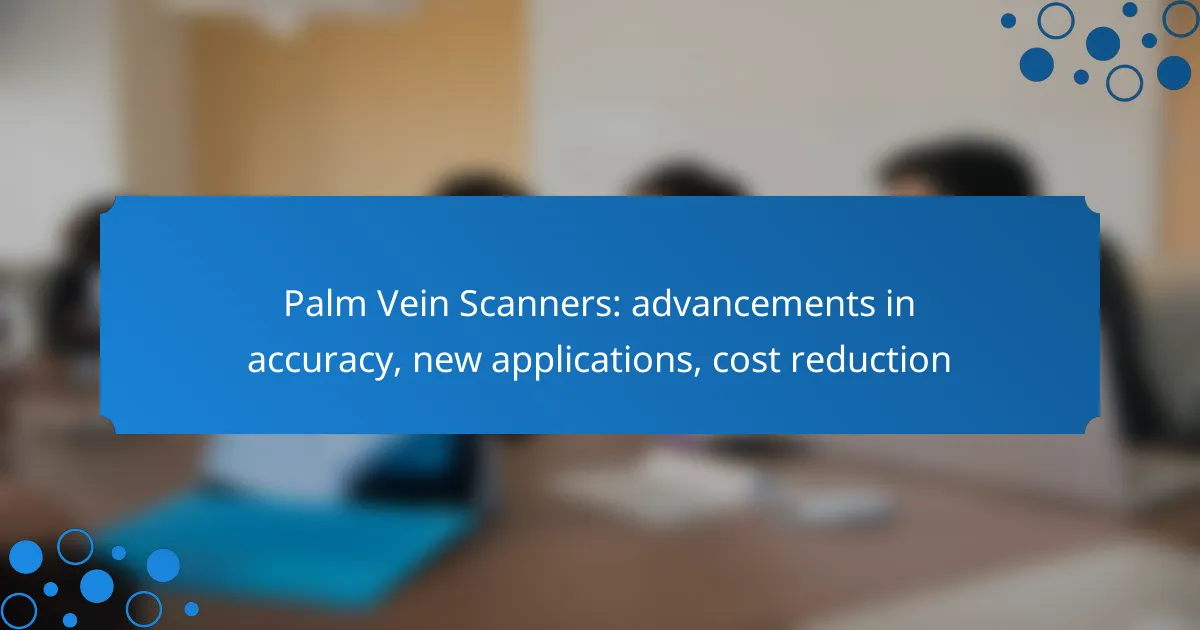Palm vein scanners are experiencing significant advancements in accuracy, driven by cutting-edge imaging technologies and artificial intelligence integration. These improvements not only enhance identification precision but also open up new applications in healthcare, secure access control, and financial transactions. Additionally, the cost of these scanners is decreasing, making them more accessible to a wider range of users and industries.
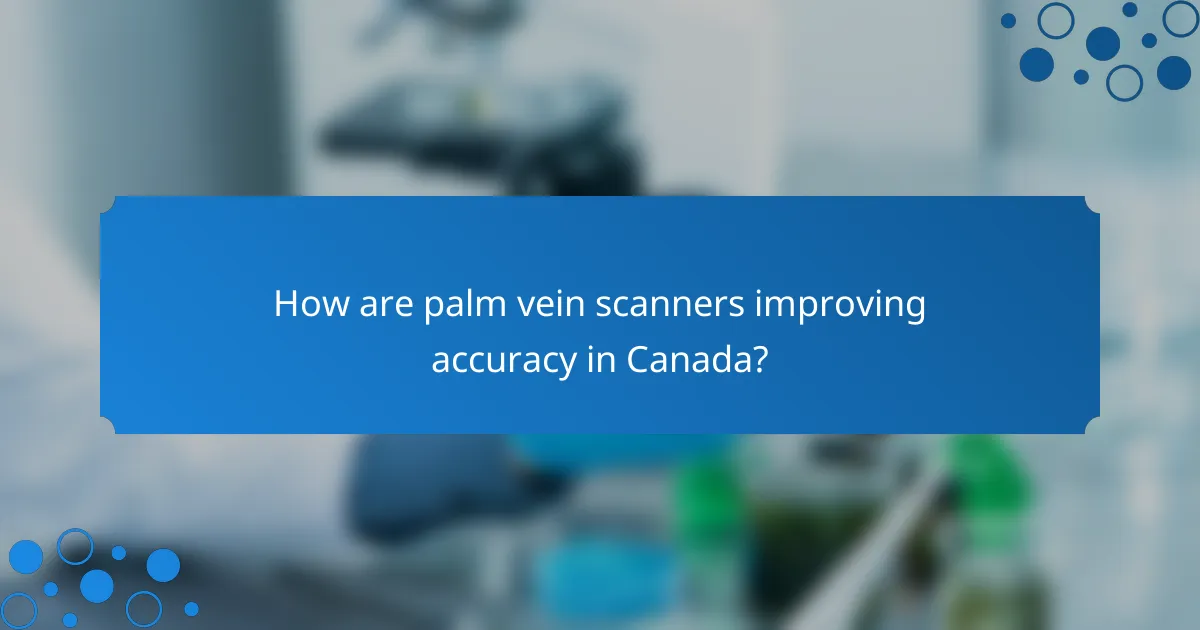
How are palm vein scanners improving accuracy in Canada?
Palm vein scanners in Canada are enhancing accuracy through advanced imaging technologies, improved algorithms, and integration with artificial intelligence. These developments lead to more precise identification and reduced false acceptance rates, making the technology increasingly reliable for various applications.
Enhanced imaging technology
Recent advancements in imaging technology have significantly improved the clarity and detail of palm vein scans. High-resolution infrared cameras capture intricate vein patterns with greater precision, allowing for better differentiation between individuals. This enhanced imaging reduces the likelihood of errors caused by poor image quality.
Additionally, multi-spectral imaging techniques are being employed, which capture images across different wavelengths. This approach helps to highlight unique vein characteristics that may not be visible in standard imaging, further boosting accuracy.
Algorithm advancements
Algorithm improvements are crucial for increasing the accuracy of palm vein recognition systems. Modern algorithms utilize machine learning techniques to analyze vein patterns more effectively, allowing for quicker and more accurate matches. These algorithms can adapt and learn from new data, continuously improving their performance over time.
Furthermore, the use of deep learning models has enabled the identification of subtle variations in vein patterns that traditional methods might miss. This leads to a decrease in false positives and negatives, enhancing overall system reliability.
Integration with AI
The integration of artificial intelligence into palm vein scanning technology is revolutionizing accuracy. AI systems can process vast amounts of data quickly, identifying patterns and anomalies that human operators might overlook. This capability allows for real-time adjustments and optimizations in the scanning process.
Moreover, AI can facilitate biometric fusion, combining palm vein data with other biometric identifiers such as fingerprints or facial recognition. This multi-modal approach significantly enhances security and accuracy, making it a preferred choice for sectors like banking and healthcare in Canada.

What new applications are emerging for palm vein scanners?
Emerging applications for palm vein scanners include healthcare patient identification, access control in secure facilities, and financial transaction verification. These advancements leverage the technology’s accuracy and security to enhance user experiences across various sectors.
Healthcare patient identification
Palm vein scanners are increasingly used in healthcare for patient identification, ensuring accurate and secure access to medical records. This biometric method reduces the risk of identity fraud and improves patient safety by linking individuals to their health information seamlessly.
Hospitals and clinics can implement these systems to streamline check-in processes, allowing patients to verify their identity quickly. This technology minimizes wait times and enhances overall operational efficiency.
Access control in secure facilities
In secure facilities, palm vein scanners provide a reliable means of access control. They offer a higher level of security compared to traditional methods like keycards or PINs, as palm vein patterns are unique to each individual and difficult to replicate.
Organizations can utilize these scanners to restrict access to sensitive areas, ensuring that only authorized personnel can enter. This application is particularly valuable in sectors such as government, finance, and research, where security is paramount.
Financial transactions verification
Palm vein scanners are being integrated into financial services for transaction verification, enhancing security during banking activities. By using this biometric technology, institutions can reduce fraud and improve customer trust in their services.
For example, banks may implement palm vein recognition at ATMs or during online transactions to verify identities. This method not only speeds up the process but also provides a secure alternative to passwords or cards, which can be lost or stolen.
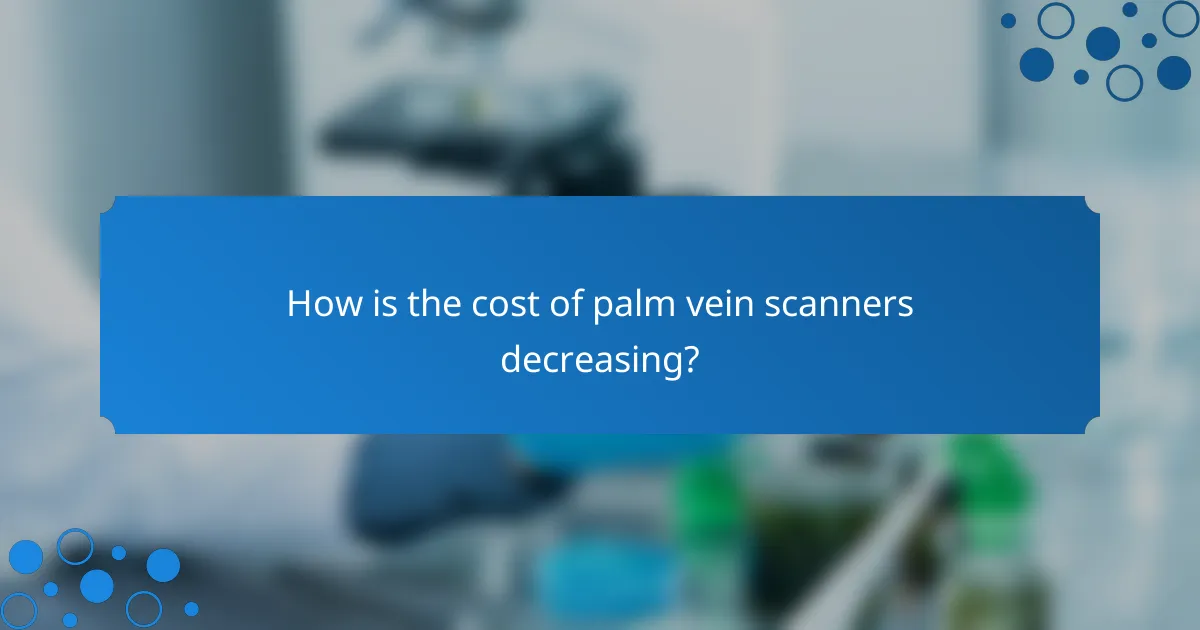
How is the cost of palm vein scanners decreasing?
The cost of palm vein scanners is decreasing due to advancements in technology, increased competition among manufacturers, and the rise of cloud-based solutions. These factors contribute to lower production costs and more affordable pricing for end-users.
Manufacturing advancements
Recent innovations in manufacturing techniques have significantly reduced the costs associated with producing palm vein scanners. Automation and improved materials have streamlined production processes, allowing manufacturers to produce devices more efficiently. This reduction in manufacturing costs can be passed on to consumers, making the technology more accessible.
Additionally, advancements in sensor technology and image processing have enhanced the performance of palm vein scanners while keeping prices competitive. For example, newer models may utilize smaller, more efficient sensors that require less power and are cheaper to produce.
Increased competition among providers
The growing number of companies entering the palm vein scanner market has intensified competition, driving prices down. As more manufacturers offer similar products, consumers benefit from a wider range of options and better pricing. This competition encourages innovation, leading to improved features and functionalities at lower costs.
Moreover, established companies are motivated to reduce prices to maintain market share against emerging players. This dynamic creates a favorable environment for buyers looking for cost-effective solutions.
Cloud-based solutions
The adoption of cloud-based solutions for palm vein scanning has contributed to cost reductions by minimizing the need for expensive on-premises hardware. By leveraging cloud technology, organizations can access advanced biometric services without the high upfront costs associated with traditional systems.
Cloud-based systems also offer scalability, allowing businesses to adjust their usage based on demand. This flexibility can lead to significant savings, especially for smaller organizations that may not require a large number of scanners at all times.
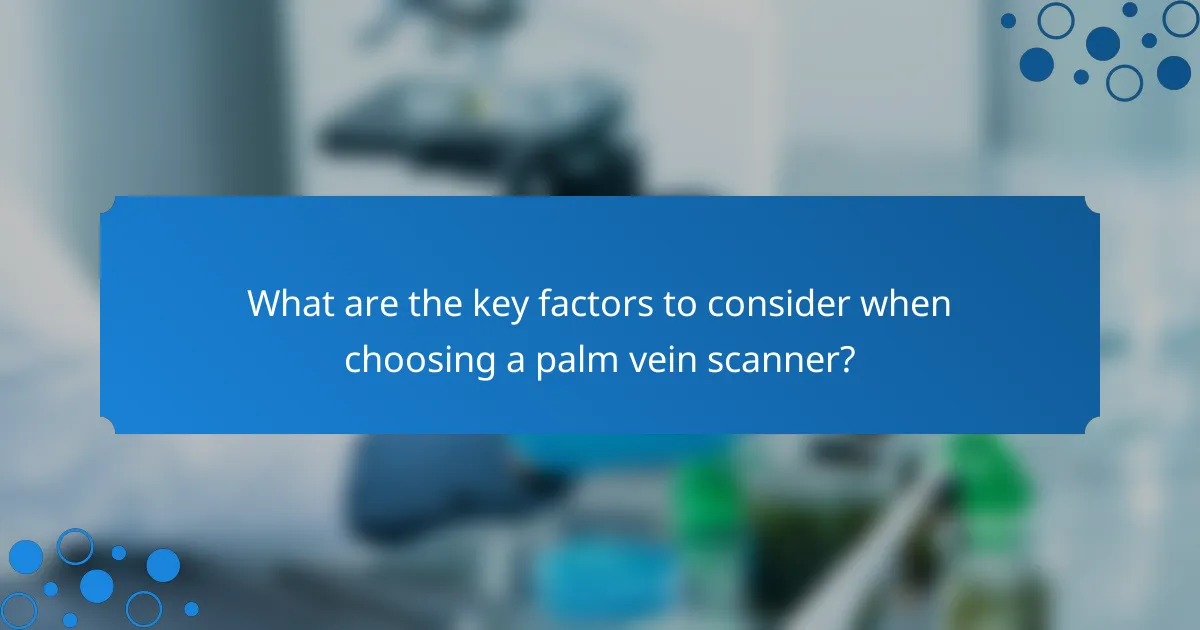
What are the key factors to consider when choosing a palm vein scanner?
When selecting a palm vein scanner, key factors include its accuracy, integration capabilities, and overall cost of ownership. These elements significantly influence the scanner’s effectiveness in various applications, from security to healthcare.
Accuracy and reliability
Accuracy is crucial for palm vein scanners, as it determines how effectively the device can identify individuals. Look for scanners that boast high recognition rates, typically above 99%, to minimize false positives and negatives.
Reliability also involves the scanner’s performance under different conditions. Consider models that maintain accuracy in varying lighting and environmental settings, ensuring consistent operation in real-world scenarios.
Integration capabilities
Integration capabilities refer to how well the palm vein scanner can work with existing systems. Ensure the scanner can easily connect with your current software and hardware, such as access control systems or databases.
Compatibility with industry standards, like ISO or ANSI, can simplify integration and enhance functionality. Check if the scanner supports common communication protocols like TCP/IP or USB for seamless connectivity.
Cost of ownership
The cost of ownership encompasses not just the initial purchase price but also maintenance, support, and potential upgrades. Evaluate the total cost over the scanner’s lifespan to make a well-informed decision.
Consider models that offer lower maintenance costs and longer warranties, as these can lead to significant savings. Additionally, factor in any necessary software licenses or training costs that may arise after purchase.
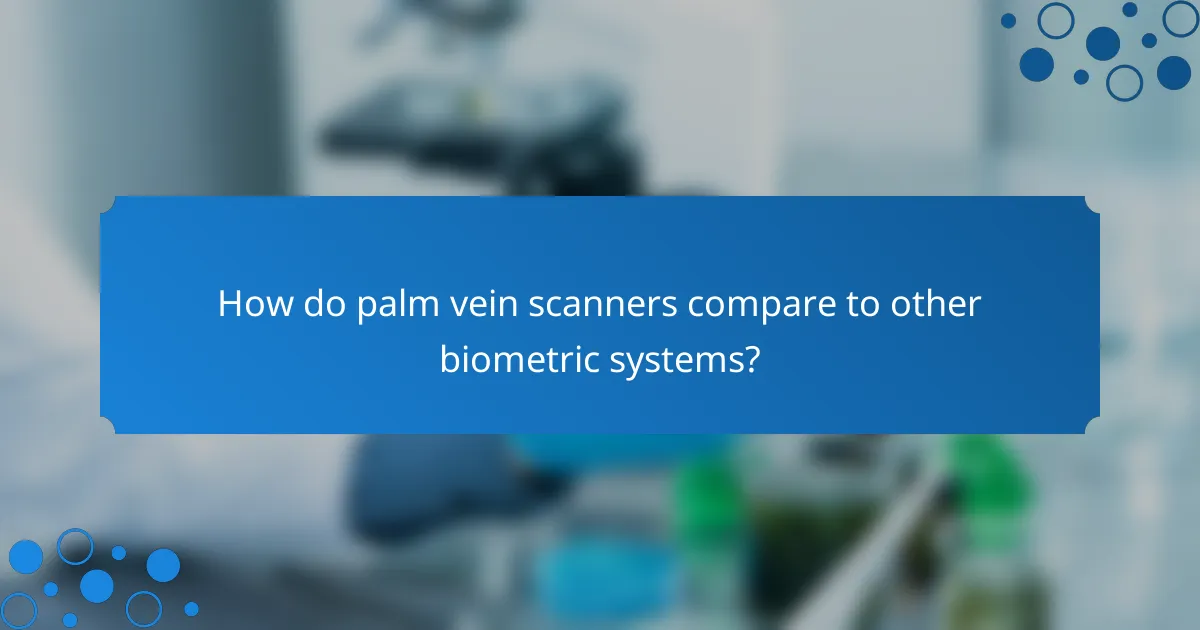
How do palm vein scanners compare to other biometric systems?
Palm vein scanners offer distinct advantages over other biometric systems, particularly in terms of accuracy and security. They utilize unique vein patterns in the palm, making them less susceptible to forgery compared to methods like fingerprints or facial recognition.
Comparison with fingerprint scanners
Fingerprint scanners rely on the unique patterns of ridges and valleys on a person’s fingertips. While they are widely used, they can be vulnerable to spoofing with fake fingerprints. In contrast, palm vein scanners analyze the vascular patterns beneath the skin, providing a higher level of security and reducing the risk of unauthorized access.
Additionally, palm vein scanning can be more hygienic, as it requires less direct contact compared to fingerprint systems. This is particularly beneficial in environments where cleanliness is crucial, such as hospitals or food service areas.
Comparison with facial recognition systems
Facial recognition systems identify individuals based on facial features and can be affected by changes in appearance, such as aging or facial hair. Palm vein scanners, however, are based on internal vascular patterns that remain consistent over time, offering a more reliable identification method.
Moreover, palm vein scanners can operate effectively in varying lighting conditions, unlike facial recognition systems, which may struggle in low light or bright glare. This makes palm vein technology a versatile option for various applications, from secure access control to time and attendance tracking.
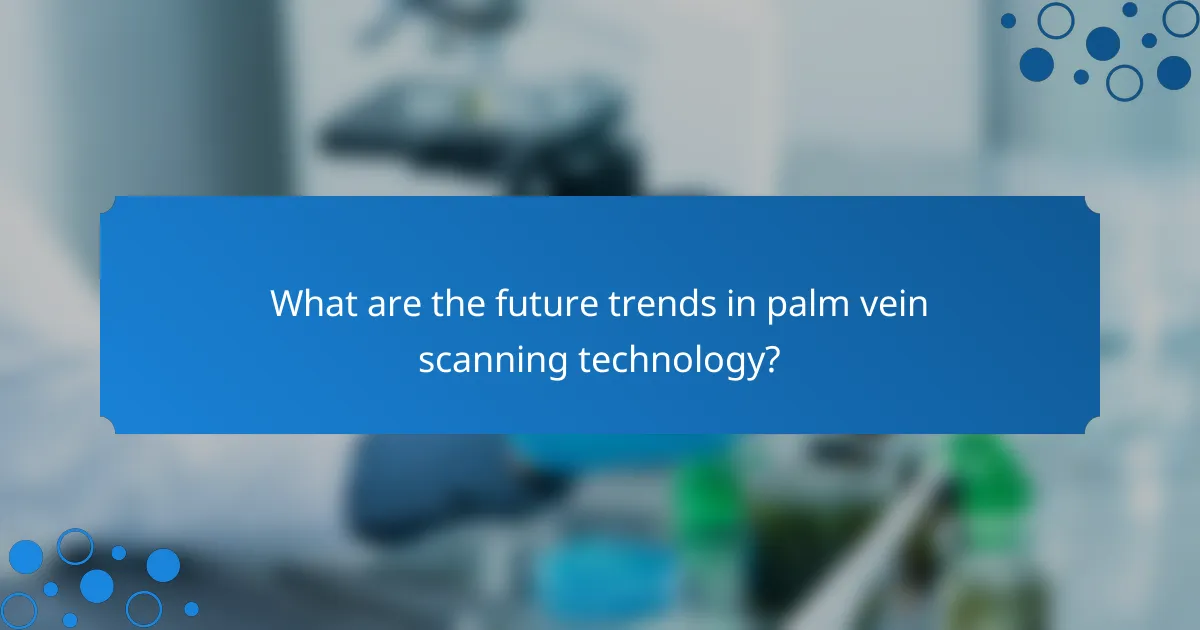
What are the future trends in palm vein scanning technology?
Future trends in palm vein scanning technology include enhanced accuracy, broader applications across various sectors, and significant cost reductions. These advancements are set to make palm vein scanners more accessible and efficient for both businesses and consumers.
Increased adoption in retail
Retailers are increasingly implementing palm vein scanning technology to streamline payment processes and enhance security. This biometric method allows for quick and secure transactions, reducing the need for cash or cards, which can be lost or stolen.
For example, some grocery chains are piloting palm vein payment systems that enable customers to pay by simply scanning their palm. This not only speeds up checkout times but also improves the overall shopping experience.
Advancements in mobile integration
Mobile devices are becoming more integrated with palm vein scanning technology, allowing for secure authentication on smartphones and tablets. This trend enhances user convenience and security, as users can unlock their devices or authorize transactions with a simple palm scan.
Companies are developing apps that leverage palm vein recognition, enabling features like mobile payments and secure access to sensitive information. This integration is expected to grow, making biometric authentication a standard practice in mobile security.
